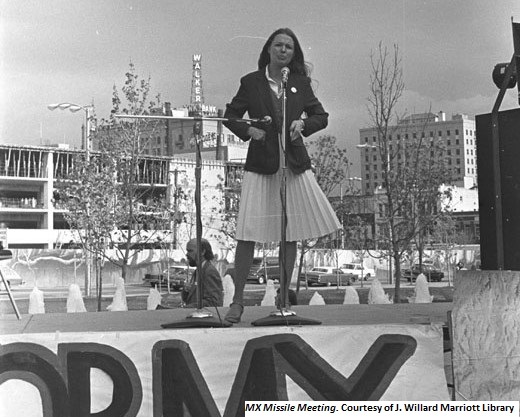Dublin Core
Title
Description
A grassroots movement of Utah citizens helped derail government plans to base the MX Missile System in Utah’s Great Basin.
When the United States Air Force announced its plans in 1979 to build its new MX Intercontinental Ballistic Missile System in Utah’s Great Basin, it could hardly have anticipated the coalition of concerned citizens that rose up in feisty opposition.
As part of its Cold War goal of nuclear deterrence, the Air Force’s MX Missile System resembled a giant game of hide-and-seek. Hundreds of warheads would constantly shuttle between thousands of empty silos, forcing the Soviet Union to waste its full arsenal in destruction of the entire network. MX was designed to absorb the brunt of any Soviet attack, and the Chairman of the US Joint Chiefs of Staff was blunt when he told residents of Utah and Nevada, “We're sorry that someone has to be the bull's-eye, but you're it!"
Sites were planned in Utah’s Beaver and Millard Counties, with construction set to begin in 1983. The MX System would consist of thousands of miles of roadway and railroad, require hundreds of support facilities, cost billions, and employ thousands. Nearly all of Utah’s elected representatives initially favored MX because of the huge boon to local economies.
But Great Basin residents were divided. Town meetings were held where citizens voiced support for patriotic duty and economic benefits, while others dreaded huge population growth, rampant development, increased water demands, and curtailment of grazing and property rights. Utah activists sought to educate the public about the project’s ramifications, with grassroots groups such as Utahns United Against MX bringing together organizations that rarely cooperated. Peace and environmental groups found themselves aligned with Native American tribes, down-winders, religious leaders, and conservative farming and ranching communities against a common foe.
The debate raged, but public opinion steadily shifted against the project. MX lost presidential support with Ronald Reagan’s election in 1980. Then, in a final blow, the LDS Church issued a statement explicitly opposing the project. By the end of 1981, the MX Missile System was dead.
Creator
Source
Image: MX Missile Meetings. Sue Dutson from the Millard County Chronicle newspaper in Salt Lake City at an MX Missile protest. Beckwith Family, Courtesy of J. Willard Marriott Library.
_______________
See Martha Sonntag Bradley, “The MX Missile Project,” History of Beaver County; Edwin B. Firmage, “MX: A Personal Essay.” Beehive History, Number 28, Salt Lake City: Utah State Historical Society, 2002; First Presidency Statement on Basing of MX Missile, “News of the Church,” Ensign, June 1981, pp. 76–80; Oral History of Utah Peace Activists project, George Sutherland Archives, Utah Valley University, Orem; The MX Missile Project; The Department of the Air Force, The MX System and the Environment, (Washington, D.C.: U.S. Government Printing Office, 1979); Utah Consortium for Energy Research and Education, Review of the U.S. Air Force's draft environmental impact statement on deployment area selection and land withdrawal/acquisition for the MX missile system : a report to Governor Scott M. Matheson, (Salt Lake City, The Consortium, 1981); Matthew Glass, Citizens Against the MX: Public Languages in the Nuclear Age, (Chicago: University of Illinois Press, 1993); Congressman Dan Marriott, MX Report and Questionnaire, (Washington, D.C., U.S. House of Representatives Public Document, February 1980); MX Information Center, MX: Boon or Boondoggle, (Salt Lake City, MX Information Center, 1980); “Air Force Misreads Public Mind: MX ‘Racetracks’ Not Wanted,” Salt Lake Tribune, February 11, 1980, page A8; “Strong Opposition to MX Expressed at Public Meeting,” Millard County Chronicle, February 28, 1980, page 1.

